Featured Comment:
“SO yummy! I made them in the morning so I could have a quick and easy lunch this afternoon. With the size of my onigiri molds I was able to make 4 medium sized onigiri and 1 small. I couldn’t help but eat the small one right away 😂 One of my favorite Japanese dishes ❤️🍙”
– Cat (from Pinterest)
What is Salmon Onigiri?
Salmon onigiri (鮭おにぎり) is a popular Japanese snack that consists of rice mixed with flakes of Japanese-style salmon and shaped into a ball or triangle. It’s a classic choice for onigiri and has been a favorite ingredient for many people throughout history.
In fact, according to CanCam.jp (2020), salmon onigiri was voted the number one variation of all onigiri ingredients.
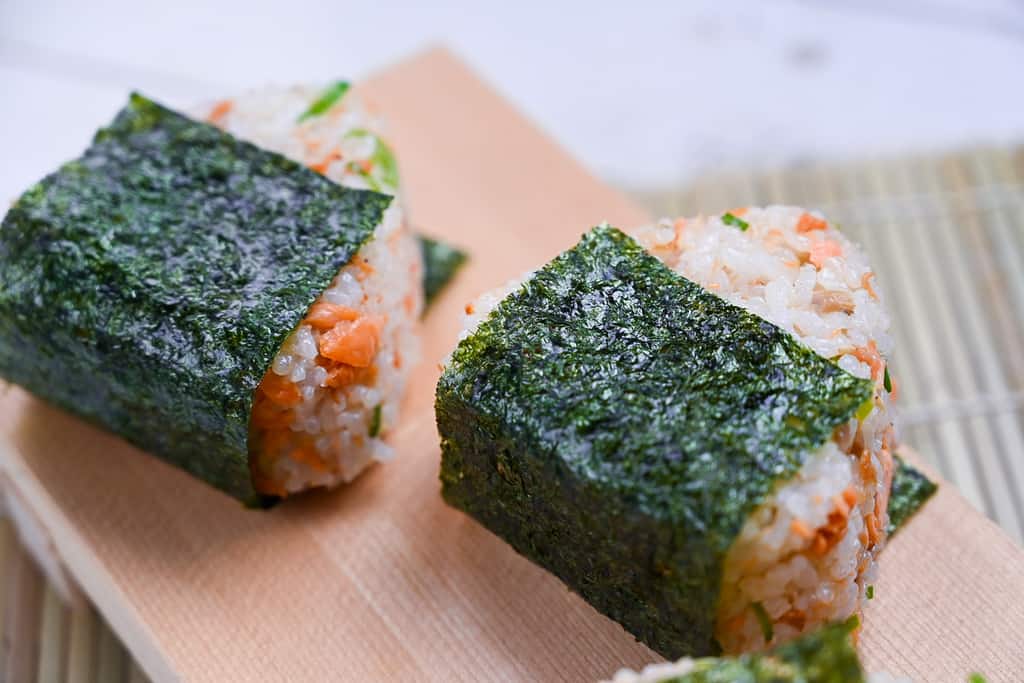

How I Developed This Recipe
What comes to mind when you think of salmon onigiri? You’d probably picture delicate flakes of salmon nestled in the center of a perfectly shaped rice ball. In fact, most salmon onigiri sold at convenience stores are of this type.
But what if we could give this popular snack a new twist? I decided to try something different and add a new twist instead of using the traditional flakes. In this recipe, salmon fillets are sautéed in butter and soy sauce, and then mixed with rice before shaping.
It might not be the classic version you’re used to, but it’s a tasty new take on the classic. If you’re looking for something new and tasty, I highly recommend giving this recipe a try!
Ingredients & Substitution Ideas
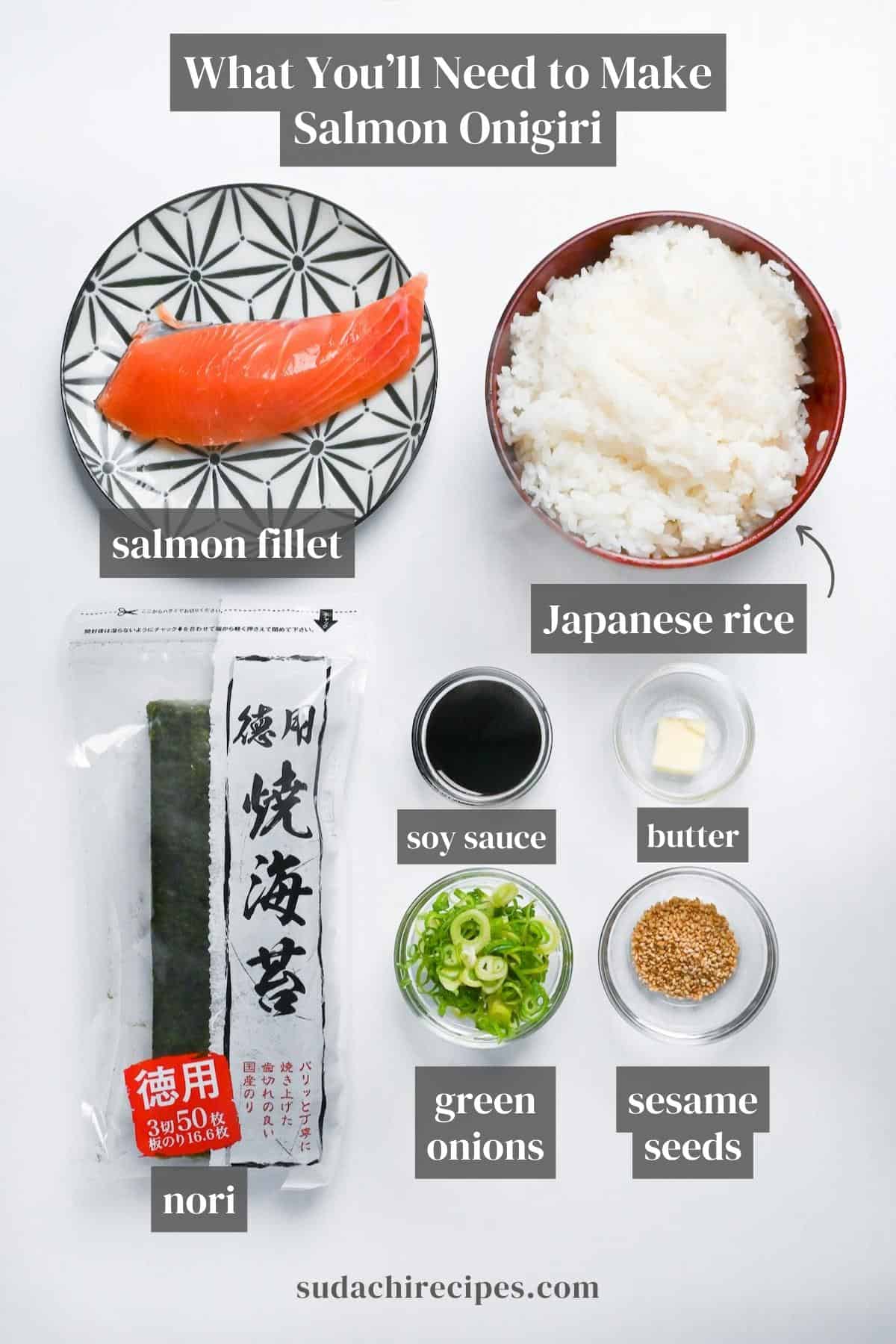
- Cooked Japanese Short-Grain Rice: It’s essential to stick to Japanese-style short-grain rice for rice balls. Using any other type might leave you with a crumbly mess. If you’re in the U.S. and wondering which Japanese rice to pick and how to cook it just right, my How to Cook Japanese Rice Recipe has got you covered.
- Salmon Fillet: Whether you keep the skin on or off is up to you. But here’s a tip: if you come across any tiny bones while cooking, pluck them out. And if you decide to go skinless, crisping peeled skin up in a separate pan and then sprinkle it over the top at the end for a flavor and texture boost!
- Soy Sauce: For recommended soy sauce brands for Japanese dishes, my soy sauce guide is the place to go.
- Unsalted Butter: Stick to unsalted butter. But if salted butter is all you have, just dial back on other salty condiments to keep things balanced.
- Finely Chopped Green Onion: It’s not just about the subtle flavor kick.
- White Sesame Seeds: Their aroma is simply irresistible and complements the dish beautifully.
- Sushi Nori Seaweeds: Used to wrap up those rice balls at the very end. While you can technically skip it, personally, I can’t imagine onigiri without that classic nori touch.
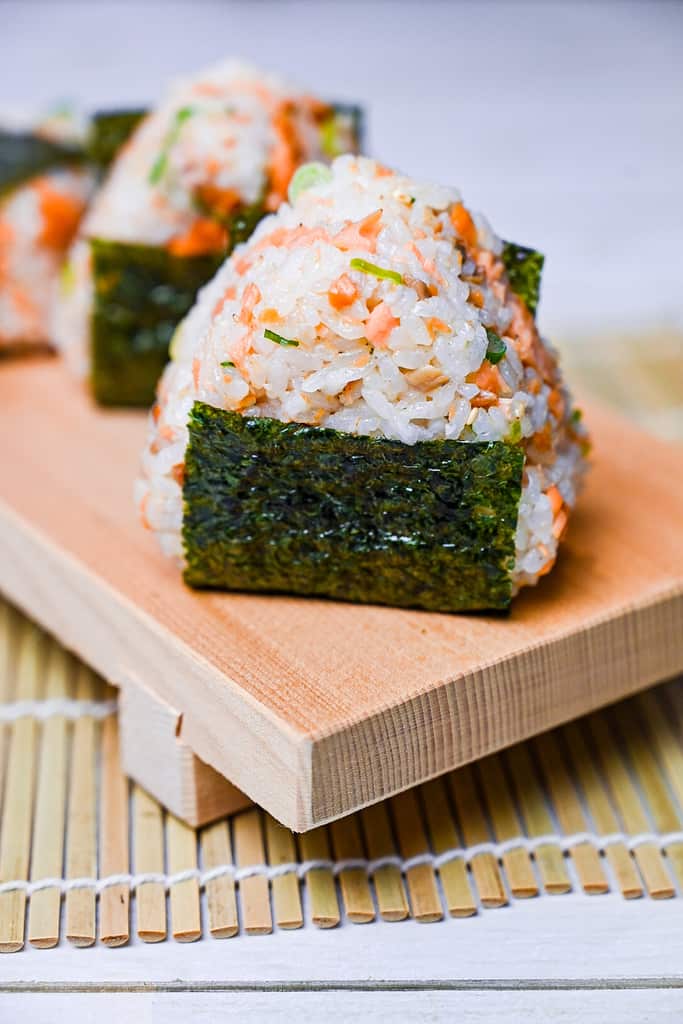
Visual Walkthrough & Tips
Here are my step-by-step instructions for how to make Salmon Onigiri at home. For ingredient quantities and simplified instructions, scroll down for the Printable Recipe Card below.
If you prefer to watch the process in action, check out my YouTube video of this recipe for a complete visual walkthrough!
To begin with, cook Japanese short-grain rice in your preferred method. If you prefer to make it on the stove, refer to my recipe “How to Cook Perfect Japanese Rice on Stove.”
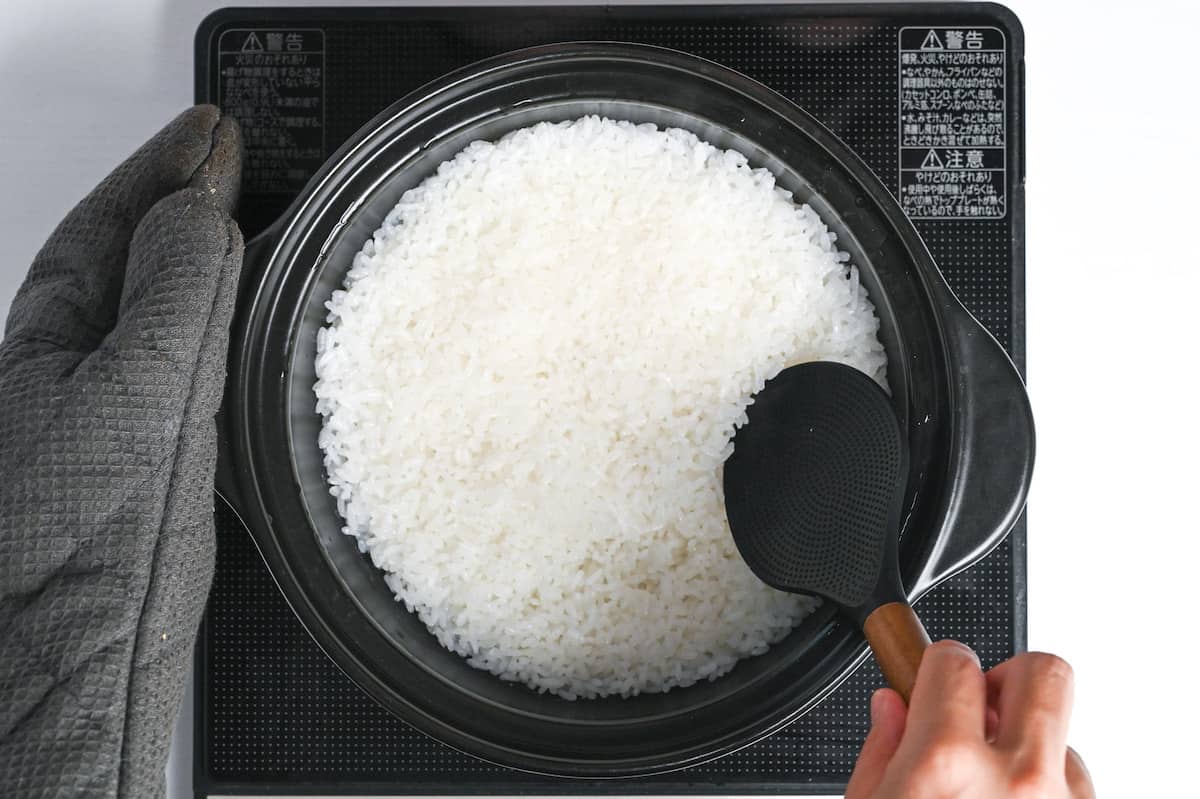
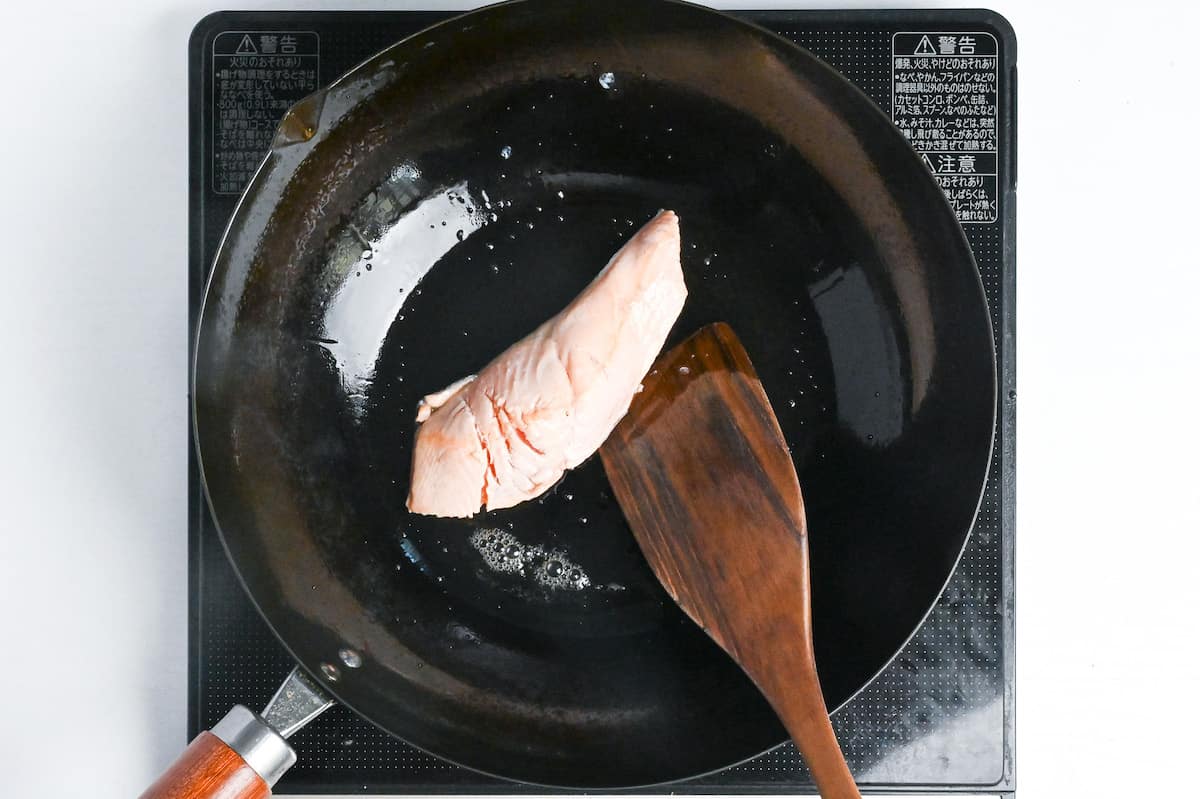
Begin by melting unsalted butter in a frying pan over medium heat. Add salmon fillet and fry until thoroughly cooked. Use a spatula to break it into smaller flakes.
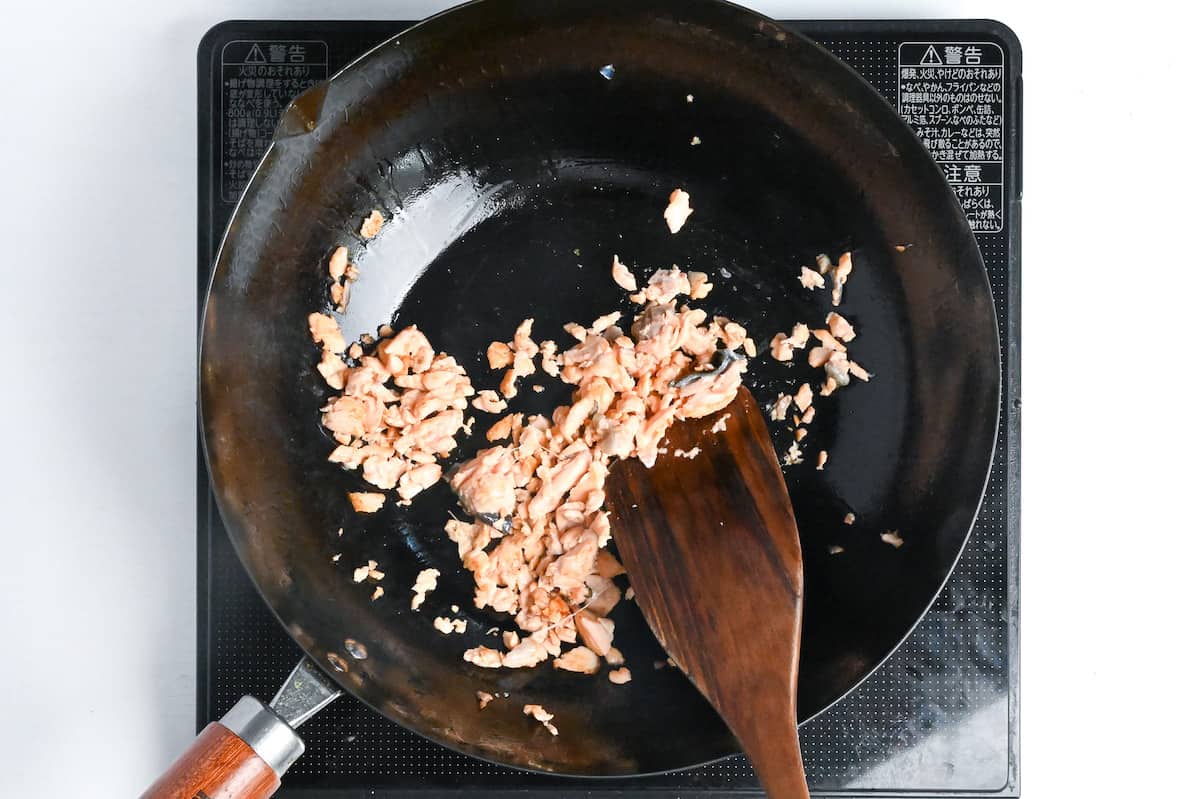
Add soy sauce to the pan, mixing well with the salmon. Continue to cook until all the liquid has evaporated.
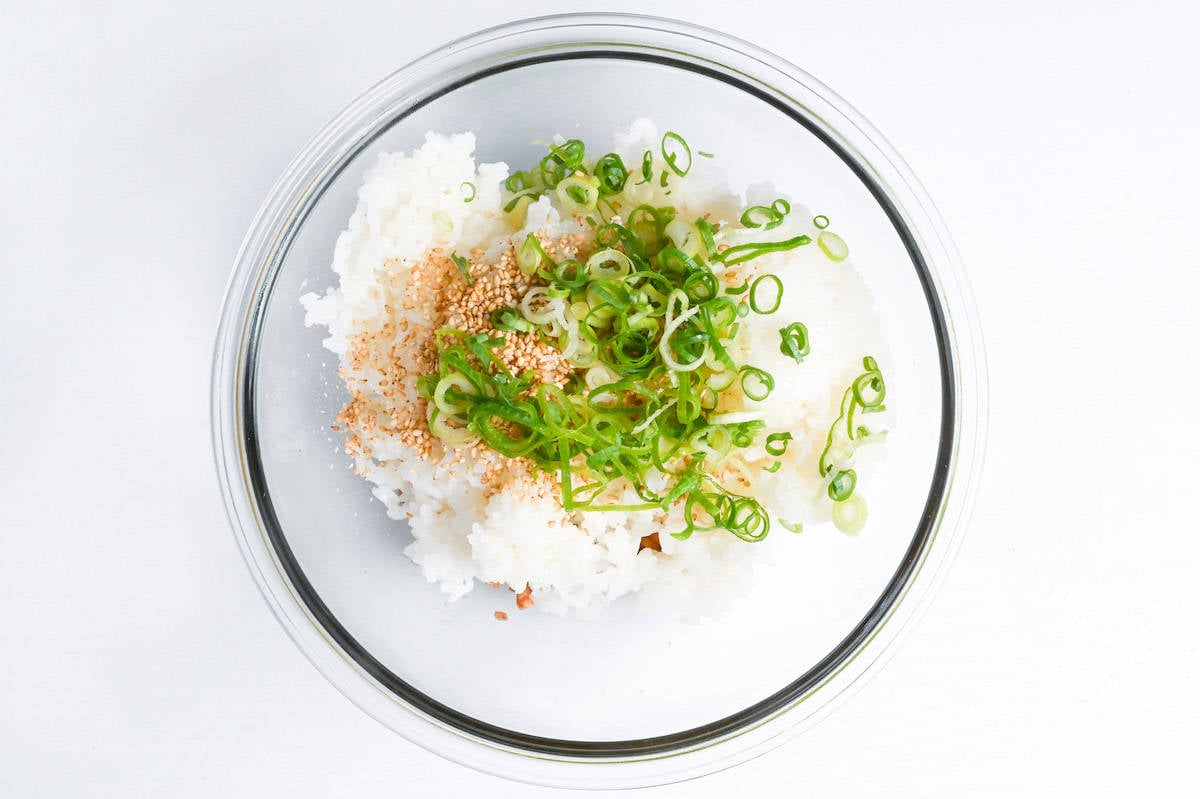
Transfer the cooked salmon flakes to a large, heatproof bowl. Add cooked Japanese short-grain rice, white sesame seeds, and finely chopped green onions.
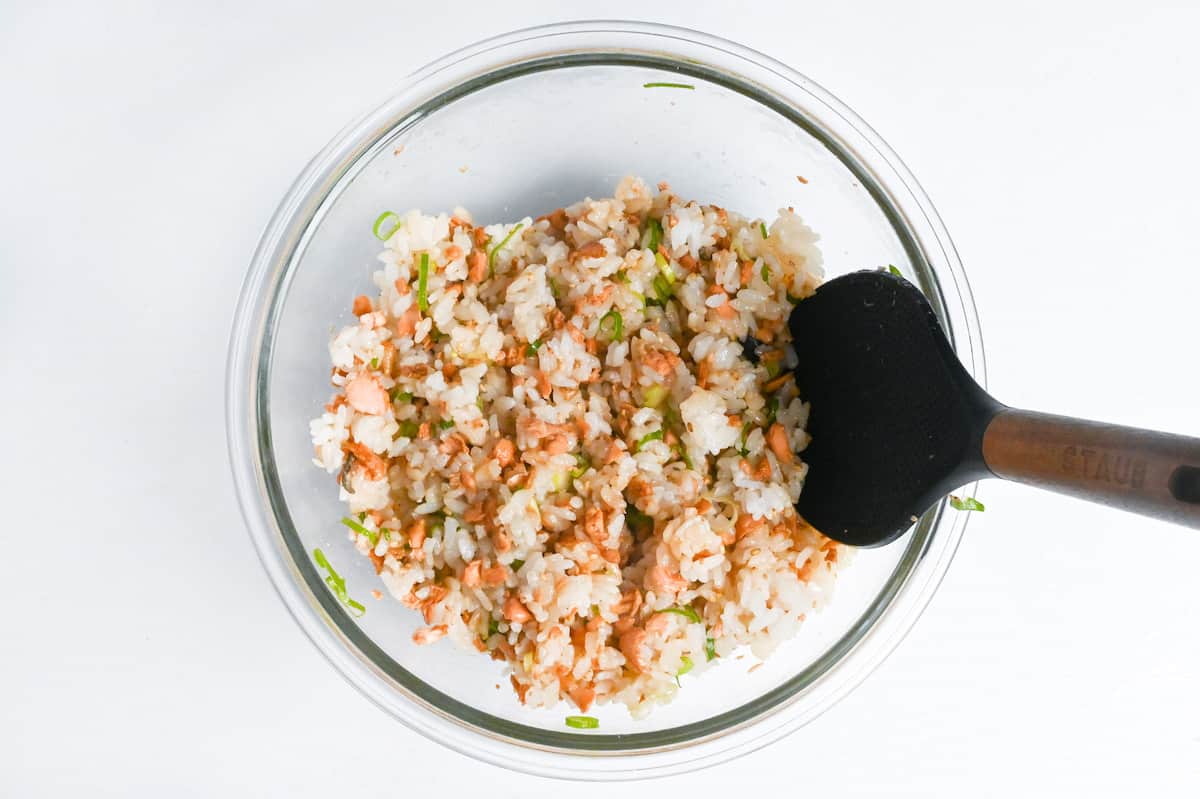
Mix well to ensure even distribution of ingredients through the rice.
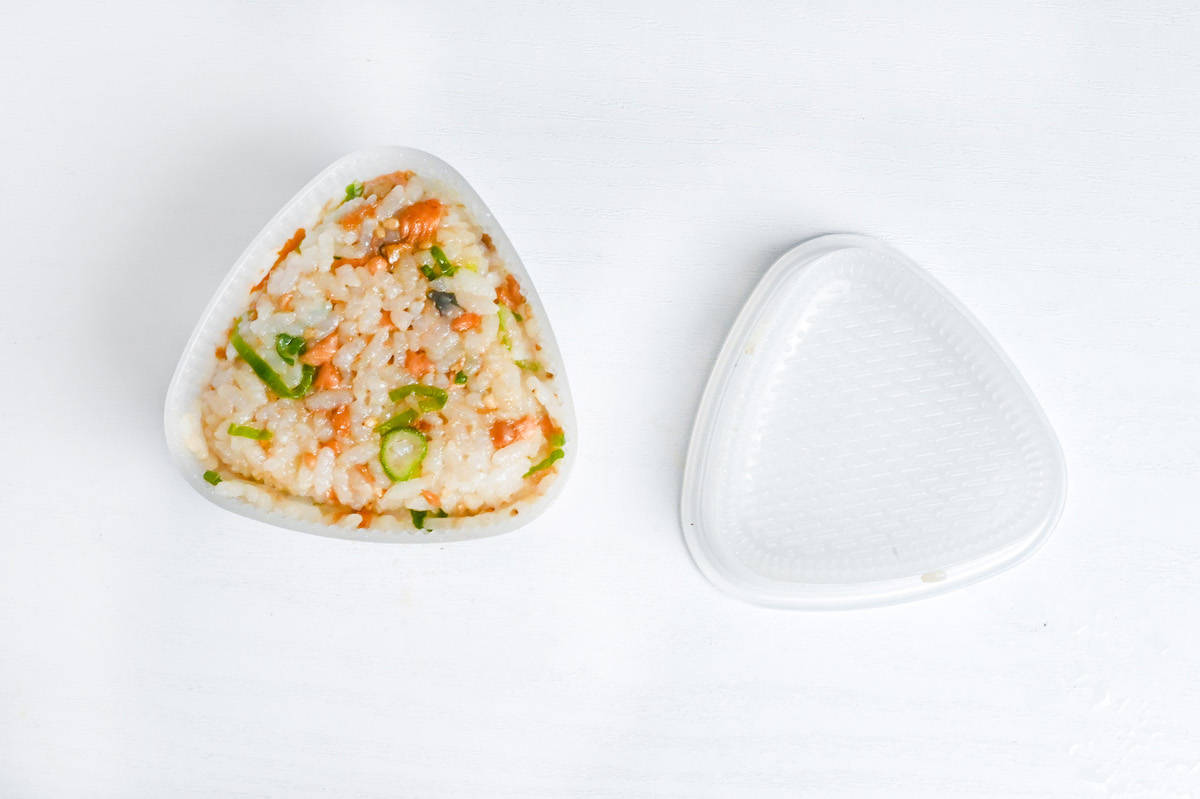
I used an onigiri mold like this one, but it’s also easy to shape it by hand.
Measure out approximately 100-130g of the rice mixture. Before shaping, sprinkle salt over your hands, the plastic wrap, or the mold.
Shape the rice into a rounded triangle, working quickly to avoid handling the rice too long.
There are several ways to shape a rice ball. You can shape it with cold and wet hands, wrap it in plastic, or use a mold. Regardless of your chosen method, the most crucial aspect is pressing the rice down firmly to maintain its shape.
In conclusion, shaping onigiri requires some practice. In my post, “3 ways to shape the perfect onigiri rice ball“, you can learn about each onigiri shaping method.
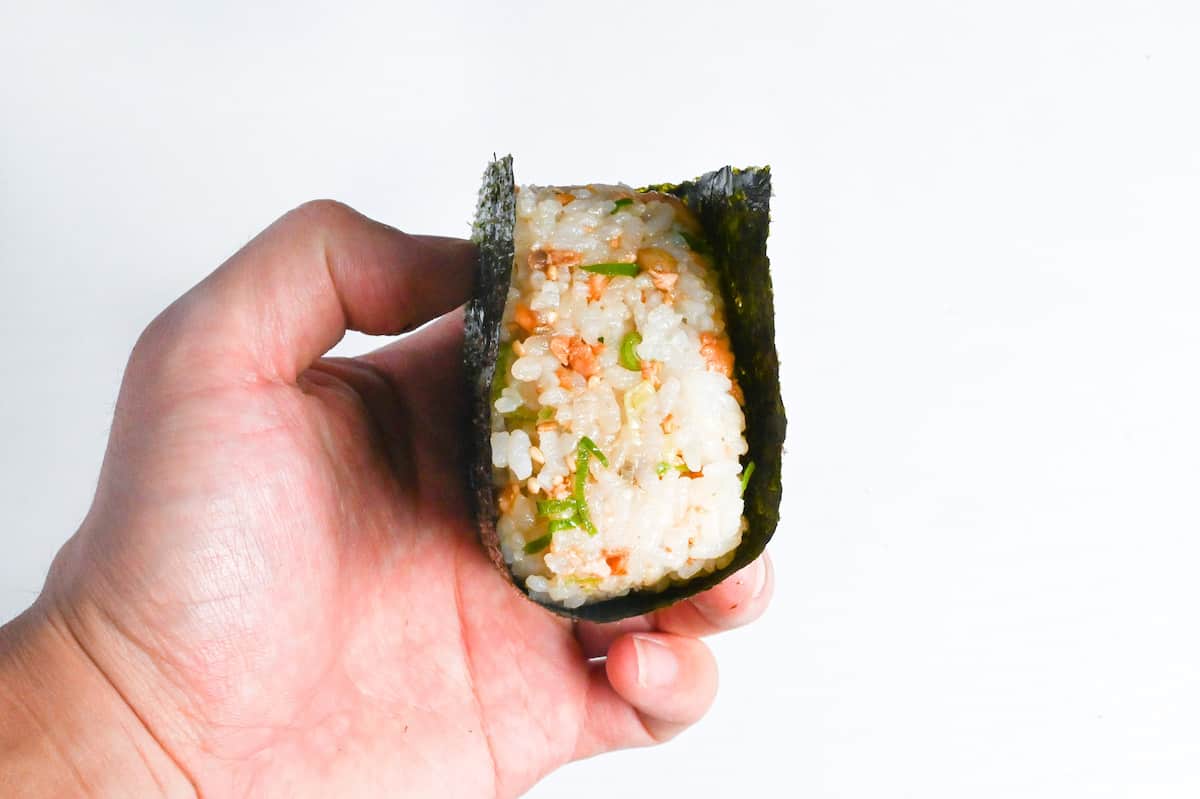
Finally, roll up the nori cut to size, and you are done!
Jump to Full Recipe Measurements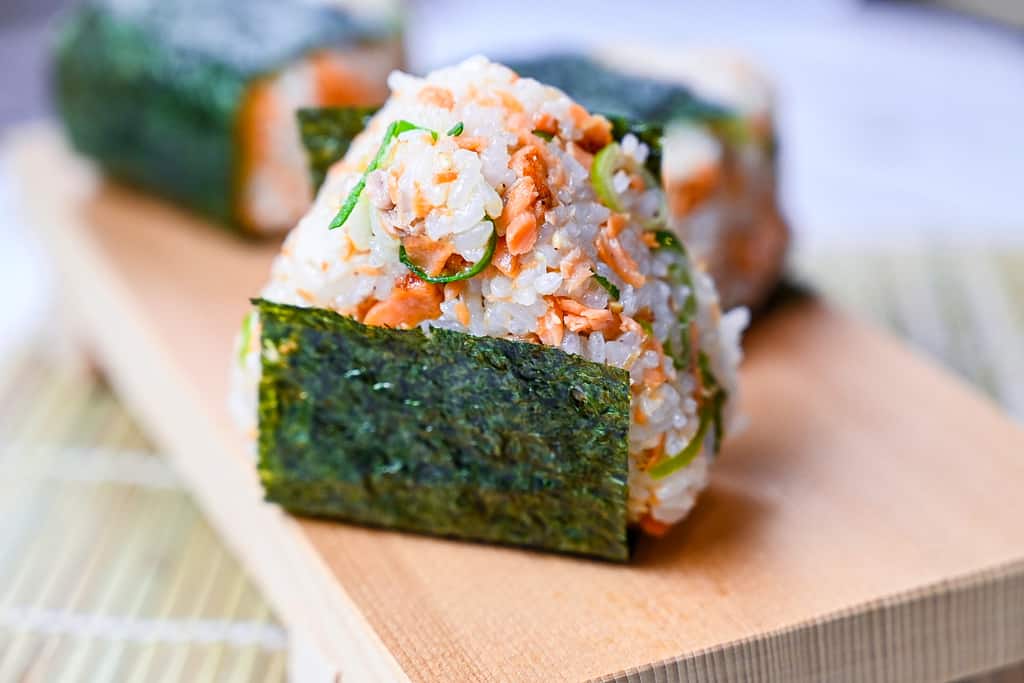
How to Store
Rice balls are best consumed fresh and do not keep well at room temperature or refrigerated. If you want to make and store them, it is recommended to freeze them.
Wrap them in plastic while still warm and place them in a freezer bag once they have cooled down. The shelf life of frozen onigiri is about one month, but the taste quality will diminish over time, so it’s best to consume them within two weeks.
To defrost the frozen onigiri, place them in a microwave oven and heat for 2 minutes at 500W. Make sure to keep the rice wrapped in plastic wrap while heating to prevent it from becoming tough. If 2 minutes isn’t enough, continue to heat for 20 seconds at a time until piping hot.
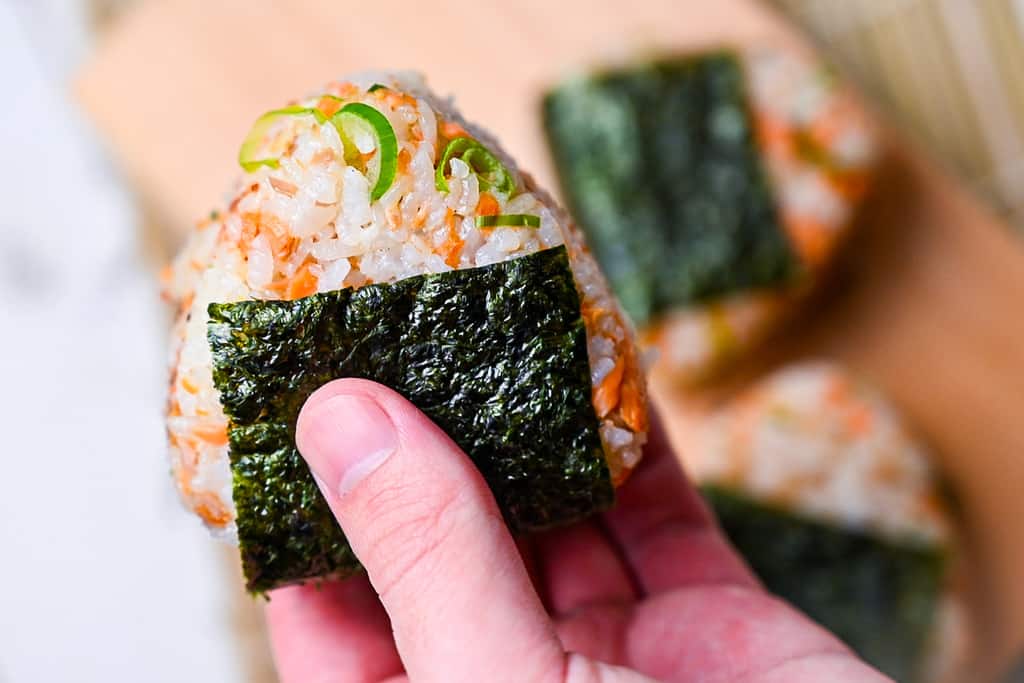
I hope you enjoy this Salmon Onigiri recipe! If you try it out, I’d really appreciate it if you could spare a moment to let me know what you thought by giving a review and star rating in the comments below. It’s also helpful to share any adjustments you made to the recipe with our other readers. Thank you!
More Onigiri Recipes
- Tuna Mayo Onigiri
- Devil’s Onigiri
- Okaka Onigiri with Bonito Flakes
- Kombu Onigiri
Hungry for more? Explore my onigiri recipe collection to find your next favorite dishes!
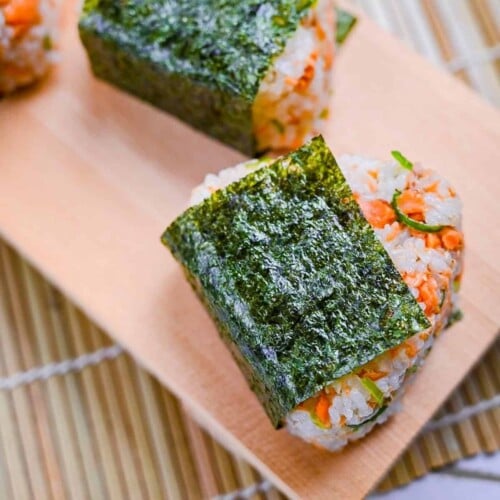
Japanese Salmon Rice Balls (Sake Onigiri)
Ingredients
- 350 g cooked Japanese short-grain rice refer to "How to Cook Japanese Rice Recipe" for brand recommendations.
- 100 g salmon fillet skin removed and deboned
- 1 tbsp Japanese soy sauce (koikuchi shoyu)
- 2 tbsp finely chopped green onions
- 1 tsp butter
- ½ tbsp toasted white sesame seeds
- 4 strips roasted seaweed for sushi (nori)
My recommended brands of ingredients and seasonings can be found in my Japanese pantry guide.
Can’t find certain Japanese ingredients? See my substitution guide here.
Instructions
- Heat up a frying pan on medium and add 1 tsp butter. Once the butter is melted, add 100 g salmon fillet to the pan and fry until it's cooked through.

- Use a spatula break it up into smaller flakes, then add 1 tbsp Japanese soy sauce (koikuchi shoyu) to the pan. Mix well and cook until the liquid is gone.

- Turn off the heat and transfer the cooked salmon flakes to a large heatproof bowl.

- Add 350 g cooked Japanese short-grain rice, ½ tbsp toasted white sesame seeds and 2 tbsp finely chopped green onions to the bowl.

- Mix well until the ingredients are evenly distributed through the rice.

- Take approx 100-130g of the rice and shape it into a rounded triangle using your preferred method. (Make sure to sprinkle salt on your hands/plastic wrap/mold first. If using bare hands, submerge them in ice cold water and rub salt over them before shaping.)

- Don’t handle the rice for too long, quicker is better. Once you’re happy with the shape, wrap it with nori.

- Enjoy!
Video
Notes
- Shape rice balls using cold wet hands, plastic wrap, or a mold—press firmly to maintain shape. For detailed techniques, see “3 Ways to Shape the Perfect Onigiri Rice Ball.”
- Consume rice balls fresh as they don’t store well at room temperature or refrigerated. For storage, freeze immediately after making.
- When freezing, wrap rice balls in plastic while warm, then place in a freezer bag once cooled. Consume within two weeks for best quality (maximum storage time is one month).
- To defrost, microwave frozen onigiri for 2 minutes at 500W with plastic wrap still on. Add 10-second intervals if needed until fully heated. Add nori just before eating.
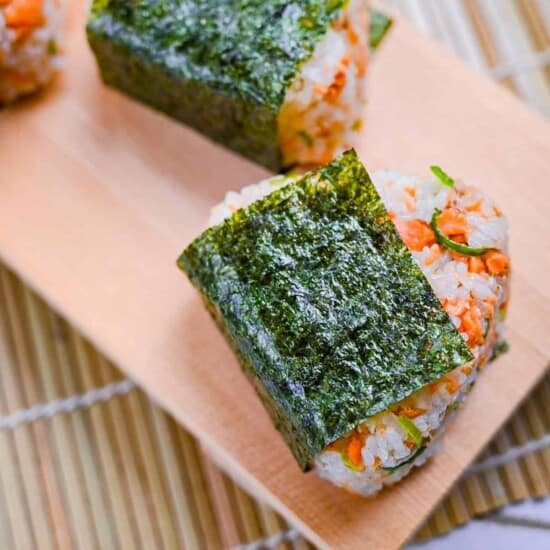





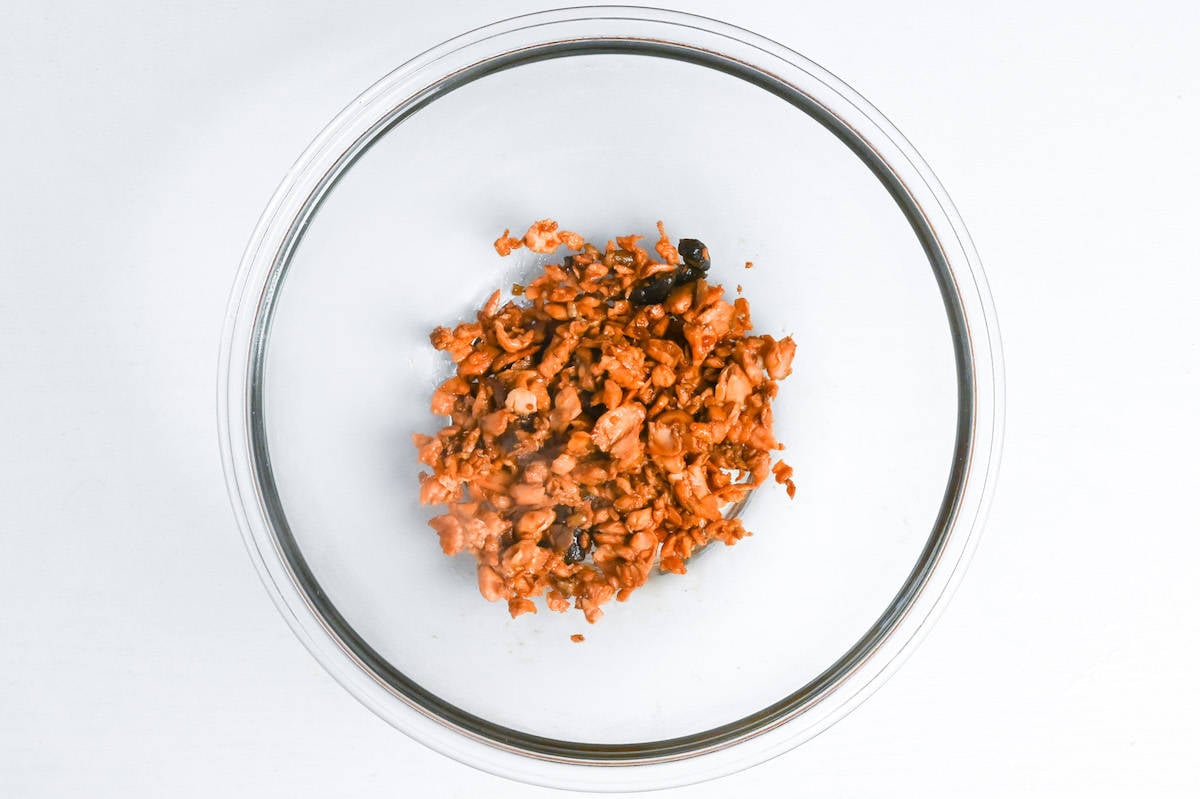
I made this once and it was so good that I’m making it again this week. Very simple recipe. However, I added furikake to my mix and made musubi instead of rolls. I’m addicted.
Thank you so much, glad you enjoyed them! Adding furikake is a great idea!
made this yesterday, so yummy.
I used the simmering water from making the savoury salmon flake recipe instead of plain water and instead of scallion/spring onions, I used a locally produced dehydrated sea lettuce and formed them up with my new Ongiri mold.
I had to double up on the recipe so now I have lunch sorted for the next couple of weeks.
love your easy to follow recipes.
Hi Trish,
Thank you so much for trying this salmon onigiri recipe! I love your creative spins! I always enjoy reading your comments and feedback! 🙂
Yuto
Hi, I kept forgetting to come back about the frozen ongiri…..when it defrosted, it pretty much fell apart so I had to mix in a bit of mayo and reform in the mold.
The top kept sticking to the lid, but a bit of clingwrap helped with that.
This was the first ongiri I’ve made and inspite of the problems I love it.
I ‘m not used to using Japanese rice and I think maybe I over washed it. I dont usually wash rice at all.
Oh, and the sea lettuce I used apparently is the same thing as Aonori.
Hi Trish,
Thanks so much for the update! Do you remember how you defrosted it? Sometimes that makes all the difference for frozen Japanese rice. New type of rice can definitely be a bit of a challenge at first, but it will definitely be easier once you get knack of it! I’m really glad you still enjoyed it! 🙂 If you’re interested and haven’t checked it out yet, here’s a full guide I made on Japanese rice: (https://sudachirecipes.com/perfect-japanese-rice/)
Yuto
I just put it in the fridge overnight.
Hi Trish,
Thank you for your explanations! I well received all of your replies. The fridge environment tends to dry out the rice, which makes the grains fall apart even though they’re naturally sticky.
And steaming is definitely a solid microwave alternative! Another method is, if you have a heat-proof bag that can be completely sealed, you can put wrapped frozen rice balls in the bag, seal it, and warm the whole thing in boiling water for 5–10 minutes. Hopefully one of these works for you next time! 🙂
Yuto